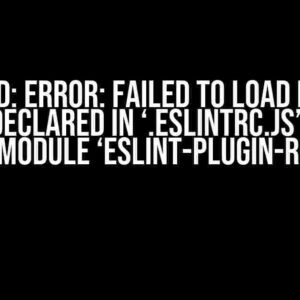Are you tired of staring at the frustrating “Failed to import external .js file” error message, wondering what on earth is wrong with your code? Fear not, dear developer, for we’ve got you covered! In this comprehensive guide, we’ll delve into the common causes of this error, and provide clear, actionable steps to resolve it once and for all.
Understanding the Error Message
The “Failed to import external .js file” error typically occurs when your HTML file attempts to load an external JavaScript file, but the browser is unable to access or read the file. This can be due to a variety of reasons, which we’ll explore in this article. But before we dive into the solutions, let’s take a closer look at the error message itself.
The error message usually appears in the browser’s console, and may look something like this:
Failed to load resource: the server responded with a status of 404 (Not Found) (index):1 Failed to import external .js file
Cause 1: Incorrect File Path or Name
One of the most common causes of the “Failed to import external .js file” error is a simple mistake in the file path or name. Double-check that the file exists in the correct location and that the filename is spelled correctly.
Solution: Verify File Path and Name
- Open your project folder and locate the external JavaScript file.
- Check that the file is named correctly and is in the same directory as your HTML file, or in a subdirectory.
- Verify that the file path in your script tag matches the actual location of the file.
- If the file is in a subdirectory, ensure that the path is correct and that the subdirectory is included in the script tag.
Cause 2: File Permissions or Access Issues
Another common cause of the “Failed to import external .js file” error is file permission or access issues. This can occur when the browser is unable to access the file due to restrictions on the server or file system.
Solution: Check File Permissions and Access
- Verify that the file has the correct permissions and access settings on your server or file system.
- Ensure that the file is not blocked by a firewall or security software.
- If you’re using a local development environment, try moving the file to a public directory or adjusting the server settings to allow access.
| File Permission | Explanation |
|---|---|
| The file can be read by the browser, but not modified. | |
| The file can be read and modified by the browser. |
Cause 3: JavaScript File Encoding Issues
Sometimes, the “Failed to import external .js file” error can be caused by encoding issues with the JavaScript file itself. This can occur when the file is saved with the wrong encoding or character set.
Solution: Check JavaScript File Encoding
- Open the external JavaScript file in a text editor or IDE.
- Check the file encoding and character set settings.
- Ensure that the file is saved with the correct encoding, such as UTF-8.
Cause 4: Script Tag Issues
The script tag itself can also cause the “Failed to import external .js file” error. This can occur when the script tag is malformed or contains incorrect attributes.
Solution: Verify Script Tag
- Check that the script tag is properly closed.
- Verify that the src attribute is correctly formatted and points to the correct file location.
- Ensure that the type attribute is set to “text/javascript” or omitted (as it’s the default value).
Additional Troubleshooting Steps
If none of the above solutions resolve the issue, here are some additional troubleshooting steps to try:
- Check the browser console for any other error messages that may be related to the issue.
- Verify that the JavaScript file is not being blocked by an ad blocker or other extension.
- Try loading the JavaScript file directly in the browser to see if it loads correctly.
- Use the browser’s developer tools to inspect the network requests and see if the file is being loaded correctly.
Conclusion
The “Failed to import external .js file” error can be a frustrating and perplexing issue, but by following the steps outlined in this guide, you should be able to identify and resolve the underlying cause. Remember to double-check file paths and names, verify file permissions and access, check JavaScript file encoding, and ensure that the script tag is correctly formatted. With patience and persistence, you’ll be back to coding in no time!
Still stuck? Feel free to ask for help in the comments below, and we’ll do our best to assist you.
Frequently Asked Questions
Get answers to the most common queries about failed external .js file imports!
Why does my HTML file refuse to import an external .js file?
Hey there! This might happen due to incorrect file paths, syntax errors, or even browser security restrictions. Double-check your file paths, ensure the .js file is in the correct location, and verify that your browser isn’t blocking the script. If all else fails, try using a CDN or a local copy of the script instead!
What’s the difference between a local and external .js file, and when should I use each?
A local .js file is stored on your computer, whereas an external .js file is hosted on a separate server. Use local files for development, testing, or when you need more control over the script. External files are ideal for production, as they reduce page load times and enable easier updates. Choose wisely, my friend!
Can I import an external .js file using the HTML import attribute?
Sorry, mate! The HTML import attribute is specifically designed for importing HTML documents, not scripts. Instead, use the script tag with the src attribute to link to your external .js file. For example: <script src="https://example.com/script.js"></script> Easy peasy!
How do I troubleshoot issues with importing external .js files?
When troubleshooting, check the browser console for errors, verify the script URL, and ensure the file is correctly linked. You can also try using the network tab in the browser dev tools to inspect the request and response headers. If all else fails, try importing the script locally or using a different CDN. Happy debugging!
Are there any security concerns when importing external .js files?
Absolutely! When importing external scripts, you’re giving them access to your site’s DOM and user data. Make sure to only import scripts from trusted sources, use HTTPS to ensure secure connections, and keep your dependencies up-to-date. Don’t let malicious scripts ruin your day!







